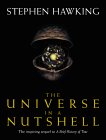18
The famous mathematician Euclid is credited with being the first person to axiomatise the geometry of the world we live in - that is, to describe the geometric rules which govern it. Based on these axioms, he proved theorems - some of the earliest uses of proof in the history of mathematics.
This book attempts to take a firm grip on a corner of the slippery issue of consciousness. It is directly related to Roger Penrose's earlier, hugely successful work, The Emperor's New Mind. Although much space is devoted to painstaking replies to the criticisms made of the earlier book, this is not simply a sequel. It contains a number of new ideas, some of which are still being actively debated seven years after the book was first published.
Research on the Universe leads to many such startling conclusions and this book attempts to describe some of the surprising phenomena which occupy astronomers and cosmologists.
Our Universe, Martin Rees' laboratory, allows its natural laws to be cleverly interpreted at arm's length, by observing the 'extreme' physics which we could never replicate in a laboratory. The biggest questions have an almost philosophical tenor.
What is the nature of the universe that we live in? This is a question that has exercised philosophers and scientists for as long as people have been able to think. Almost everyone has asked it at one time or another, in one form or another. It is hard to imagine a more fundamental question.
ver the last hundred years, human understanding of the nature of the universe has expanded at a mind-boggling rate; and over the last forty, Kip Thorne, along with Stephen Hawking, who wrote the foreword to this book, have been among the group of people shining most light into the darkness. But, aware that his research is carried out on behalf of us all, Thorne has not neglected the task of explaining its results to the rest of us.
Set your beloved heart a-flutter with this mathematical valentine
What happens when one black hole meets another? Professor Kip Thorne shows us how to eavesdrop on these cosmic events by watching for telltale gravitational waves.
Nobel Prizewinning Physicist Professor Gerardus 't Hooft has always been fascinated by the mathematical mysteries of nature. He tells Plus about his early life, and what our Universe might really be like.
Astronomer Royal Sir Martin Rees gives Plus a whistlestop tour of some of the more extraordinary features of our cosmos, and explains how lucky we are that the universe is the way it is.
Will we ever be able to make computers that think and feel? If not, why not? And what has all this got to do with tiles? Plus talks to Sir Roger Penrose about all this and more.





